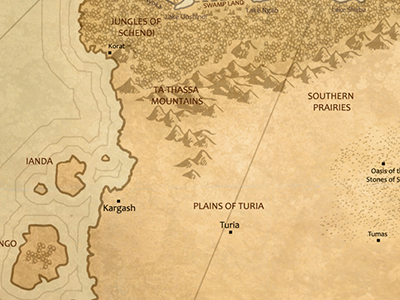The Turian Plateau
Home to the richest and most arable farmland in all the southern plains, this elevated tableland is named after the great city at its center. In addition to mighty Turia itself, the plateau is dotted with countless peasant huts, typically arrayed to form small peasant villages, and the estates and villas of High Caste Turians.
Smallest of the half-dozen informal 'regions' of the Plains, the Turian Plateau more or less consists of everything within a single day's ride (by tharlarion) of the city itself. Unlike the rest of the Plains, where Turia has often projected power in the past, the plateau rests comfortably within Turia's control. Though many of the farms were burned during and after the recent Tuchuk Sack, the Wagon People have not elected to contest Turia's claim to its own backyard. Thusfar.
The Ta-Schendi Steppe
The open steppeland north of the Turian Plateau and south of the Schendi jungles is overrun by the Wagon People; what few Turian farms that once were in the lower grasslands have been put to the torch and the lance. While none of the tribes currently rest their wagons in the Ta-Schendi Steppe, all four tribes routinely seek the shelter of the western mountains and northern jungles to make their winter pastures.
The road known to Turians as the Avto Kasra, and to the rest of central Gor as the Southern Salt Line, runs through the Ta-Schendi Steppe before entering the Cartian Valley. Other key features include the Omen Valley where wagonfolk haruspexes read the signs in bosk livers, and the Plain of 1,000 Stakes where the games of Love War take place.
The Crimson Fields
While the port town of Kargash is safe and secure on the far side of the Ta-Thassa Mountains, the road to Kargash runs through the Crimson Fields, west of the Turian Plateau, before reaching the safety of the mountain passes and the Turian forts defending them. The Kataii have made the Fields their home for the time being, and no caravan makes the journey through their territory unscathed.
Once, the Crimson Fields were so-named for the fiery tunics of the Turian warriors who marched out each spring to secure the safety of the Avto Karga and peasant farms. After the Sack, the meaning of the name has changed - now a grim recognition of the Turian blood that feeds the earth with every Kataii raid.
The Unbordered Grasslands
The deep southern plain goes on seemingly forever, though the soil gets poorer and poorer (for grazing or farming) the further south one goes. As a result, Turian farms always kept to the north of this region, meaning the great city rarely came into conflict with the Wagon People over these lands. Now only the Wagons of the weakened Paravaci tribe make their homes here.
Unlike most of the other regions, no significant trade routes or important roads travel through the Unbordered Grasslands. Little beyond the endless grasses and the wagons of the Paravaci dot the landscape, and the weakest of the wagon tribes chafe at having been denied the opportunities for riches and plunder their brethren enjoy.
The Lost Prairies
In better times, Turia sought to contest Tor's position as the "gateway" to the Tahari and its lucrative dominance over the desert trade (salt, spices, dates, and other desert goods). The fulcrum of these economic sorties against the second city of the south was the merchant-fortress of Turmas, nestled on the edge of the Tahari, offering traders an alternative route to the desert with superior access (via Kargash) to the sea.
Following the Sack, that power is at an end - the Prairies are lost to Turia, and the Kassar tribe has made the area home to their wagons. Turmas is besieged, the Kassars hungry for the riches and plunder it holds, and the once relatively-safe Avto Turma is now overrun.
The Cartian Valley
Whether the lands south of the Cartius River and northeast of the Ta-Schendi Steppe are even part of the plains at all is a matter of debate. Turian influence in this far-off region was never more than nominal - with Tor dominating the desert trade leaving the Tahari, and Kasra commanding the most stable crossing of the Cartius.
Kasra is connected to Turia by what the rest of Gor calls the Southern Salt Line, and those of Turia call the Avto Kasra, which wends north-east through the Cartian Valley until it reaches that river port (whereas the Northern Salt Line runs north from Kasra, all the way to the far-off crossroads city of Torcadino). Through this great highway, Turia is connected to the rest of central Gor, while the Avto Toria branches off eastward to reach the city of Tor.
Now the Tuchuks have brought their wagons to the Cartian Valley, ranging far from their usual grazing lands, hungry for new opportunities for riches and plunder. Whether Kamchak, the newly-annointed Ubar-San, will content himself with the wealth available here or range north across the Cartius remains to be seen.











